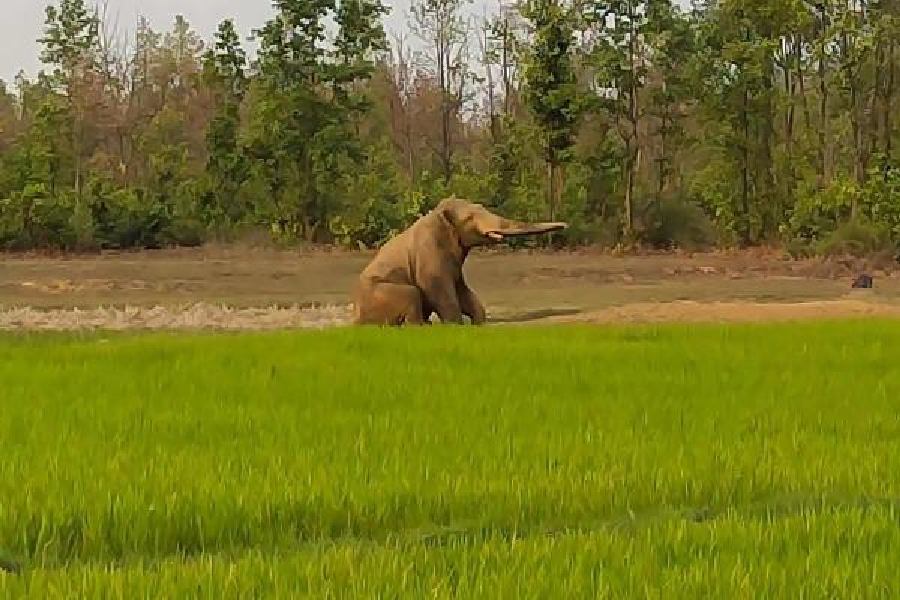The land was tilled in February. The seeds were sown in March. The first crop was seen in April. Then came the jumbos who gobbled it all up.
In a pocket of Jhargram, around 40,000kg of paddy was grown on 50 bighas of land bordering the forest. But not for humans. The cultivation was done so that the elephants straddling the forests can eat the crop.
In south Bengal, the jumbos routinely raid the fringe villages because the forests lack enough food. People die, farmlands are ravaged and homes are damaged in the raids. Elephants have also been killed in retaliation, by death traps like live wires. Villagers often organise unregulated hulla parties, using flaming torches and cannon balls to drive away elephants in violation of court orders.
The cultivation near Rehara forest in Jhargram’s Jamboni block is part of a pilot project that foresters and wildlife experts said could be expanded to other parts of the state.
The project also includes the installation of solar fencing, planting saplings known to be elephant fodder and compensating villagers for crops lost in elephant raids.
“We leased around 50 bighas of land from some 30-odd families. The lease period was January to June. Between April-end and May-end, elephants came to the paddy fields for 28 days. Sometimes in groups and sometimes in smaller numbers,” said Suvrajyoti Chatterjee for Human and Environment Alliance League, an NGO steering the project.
The NGO shared with this newspaper camera footage showing elephants visiting the new farmlands — located strategically within or near elephant ranges — at night and day.
“The 50 bighas leased from villagers border the forest. The villagers were not too keen to cultivate the land for fear of elephants, especially in the dry months of summer and winter, when the resources are scant inside the forests. As a result, the frequency of the raids goes up. In monsoon, when the forets are more bountiful, the raids are rare,” said Meghna Banerjee of HEAL.
Despite the cultivation, some farmlands closer to the human settlements were still raided by the jumbos as they travelled from one forest to another. The land owners were compensated for the loss. They were not given money but paddy seeds.
“A total of 8,574kg of paddy grains were distributed among 136 beneficiaries,” says the project report, which has been shared with the forest department.
Solar fencing has been installed along a 5km stretch, bordering six villages — Bhursan, Kuraria, Malbandi, Kendangri, Telamuri and Choto Kuraria — to provide safety against elephant intrusion.
The project has produced results, said residents.
“Even last year, we suffered because of multiple elephant raids. But this year, the number has gone down sharply. Solar fencing has reduced our fear. More people are now willing to lease their land to cultivate paddy for the elephants,” said Chunaram Hansda, a resident of Malbandi village.
The annual administrative report in 2020-21 published by the forest department points to 14 human deaths in Jhargram. The department is yet to publish the subsequent annual reports on its website.
Sources said the total number of deaths by elephants in Jhargram was 24 in 2022-23 and 17 in 2023-24.
In the second week of August, an elephant — one of five that strayed into Jhargram town — was killed after being speared by a burning iron rod, apparently by a member of a hula party.
The long-term step in the latest pilot in Jhargram, which aims to mitigate this conflict, is plantation of saplings along the forest borders.
More than 13,000 saplings have already been planted along elephant corridors. They belong to a list of 19 species, which are preferred by elephants and can thrive in the local ecosystem. The species include java plum, jackfruit, mahua, wood apple, Indian beech and custard apple.
The saplings are expected to grow into edible trees in around three years.
“We aim to replicate this model on a larger scale, expanding our reach to other conflict-prone regions and addressing the complex issue of human-elephant conflict,” said Chatterjee.
The project is part of the CSR initiative of Coforge, a digital services and solutions provider.
A senior forest official lauded the Jhargram project saying it could be a model but insisted on investment from the private sector.
“We are already installing solar fencing at multiple places on our own. The regular plantation drives inside forests now include a majority of species that are elephant fodder. But we have a resource crunch. The participation of the private sector provides momentum to this work,” said the official.
Debal Ray, the chief wildlife warden of Bengal, told The Telegraph: “I have received a copy of the project report in Jamboni. The initial findings are encouraging. But a detailed study is needed before the steps can be replicated elsewhere”.











